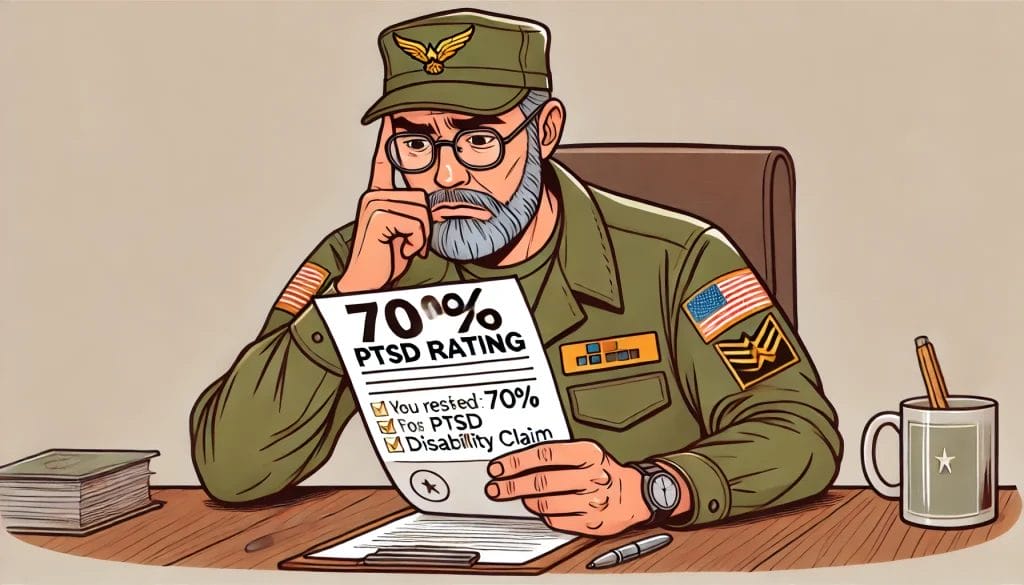Veterans suffering from Post-Traumatic Stress Disorder (PTSD) may qualify for varying levels of VA disability compensation based on the severity of their symptoms.
One of the most common ratings assigned to veterans with significant but not fully incapacitating PTSD is the 70% PTSD rating. This guide will explore what the 70 PTSD rating means, how it’s determined, and whether it can be considered permanent.
What Is a 70 PTSD Rating?
A 70 PTSD rating means that the veteran’s symptoms significantly impair their ability to function socially and occupationally. Veterans with this rating experience major difficulties in everyday life, but they are not considered to have complete social or occupational impairment, which would warrant a 100% rating.
The VA assigns a 70 PTSD rating when veterans demonstrate severe symptoms, such as:
- Suicidal ideation
- Panic attacks (near-continuous)
- Severe depression or anxiety
- Impaired impulse control (unprovoked irritability with periods of violence)
- Difficulty adapting to stressful circumstances (including work or social settings)
- Inability to maintain effective relationships
For more on how the VA determines PTSD ratings, visit this comprehensive guide: VA Disability Rating for PTSD.
Need Some More Help with your VA Disability?
Learn more about the VA Disability process and get help with our VA Disability Chatbot programmed and trained by AI

Is a 70 Percent PTSD Rating Permanent?
The permanency of a 70 PTSD rating depends on whether the VA deems the condition to be static and unlikely to improve with treatment. PTSD is generally considered a chronic condition, but some veterans’ symptoms may improve with time and therapy. As a result, the VA might classify some veterans’ 70% ratings as temporary if there is potential for improvement.
However, if the VA determines that a veteran’s condition is not expected to improve, the 70% PTSD rating can be classified as Permanent and Total (P&T). When this designation is made, the veteran will not be required to attend future re-evaluations, and their benefits will continue indefinitely.
To explore more about how Permanent and Total (P&T) ratings work, visit: VA’s Guide on Compensation Rates.
Symptoms Associated with a 70% PTSD Rating
Veterans assigned a 70% rating for PTSD typically experience the following symptoms:
- Near-continuous panic or depression: Severe emotional distress that impacts most areas of daily life.
- Impaired impulse control: Difficulty controlling anger, leading to violent outbursts or aggressive behavior.
- Severe difficulty in maintaining relationships: Veterans with a 70% rating may find it challenging to maintain family, social, or work relationships due to their condition.
- Difficulty adapting to stressful situations: Veterans may struggle in work environments or social situations, often withdrawing due to an inability to handle stress.
These symptoms must significantly interfere with both occupational and social functioning to warrant a 70% rating.
How Does the VA Determine a 70% PTSD Rating?
The VA’s PTSD rating criteria are outlined in the General Rating Formula for Mental Disorders, which can be found in 38 CFR § 4.130. The VA assigns ratings based on the frequency, duration, and severity of symptoms.
To receive a 70% rating, the veteran’s PTSD must demonstrate more than moderate impairment. Veterans with occasional symptoms or intermittent social/occupational impairment might be rated at 50%, while veterans with total impairment due to PTSD may qualify for a 100% rating.
The VA considers multiple factors, including:
- Psychiatric evaluations and medical records
- Compensation and Pension (C&P) exam results
- Statements from family members, co-workers, or employers regarding the impact of PTSD on daily functioning
You can review a detailed example of how the VA evaluates PTSD claims through this case: VA Appeal Case for 70% PTSD Rating.
Can You Increase a 70% PTSD Rating?
In some cases, veterans may experience a worsening of their symptoms over time. If a veteran’s PTSD worsens to the point of total occupational and social impairment, they may qualify for a 100% PTSD rating. Veterans seeking an increase in their PTSD rating should:
- Gather Medical Evidence: Provide updated medical records showing that PTSD symptoms have worsened since the last evaluation.
- Submit a DBQ for PTSD: The Disability Benefits Questionnaire (DBQ) should be completed by a licensed healthcare provider. It should outline the current severity of symptoms and how they impact daily life.
- File VA Form 21-526EZ: This is the official form used to request an increase in disability compensation. Veterans can file it online through the eBenefits portal or with the assistance of a Veterans Service Officer (VSO).
For more on increasing your PTSD rating, check out this resource: Increasing a VA PTSD Rating.

70% vs. 50% PTSD Rating: What’s the Difference?
The key difference between a 50 PTSD rating and a 70 PTSD rating is the level of occupational and social impairment. Veterans rated at 50% typically have more moderate symptoms, such as:
- Panic attacks occurring more than once a week
- Flattened affect (reduced emotional expression)
- Difficulty understanding complex commands
- Impaired judgment and difficulty maintaining work relationships
In contrast, veterans with a 70% rating have more severe impairment, including continuous panic attacks, suicidal ideation, and an inability to function effectively in most situations. Veterans rated at 50% can typically maintain some level of employment and social interaction, while those rated at 70% struggle significantly.
For more on conditions secondary to PTSD and mental health conditions, check out this article on the connection between IBS and PTSD.
VA Compensation for a 70% PTSD Rating
Veterans with a 70% PTSD rating can receive monthly compensation based on the VA’s compensation rates. As of 2023, the monthly benefit for a veteran with a 70% disability rating is:
- $1,663.06 for a single veteran with no dependents.
- $1,852.96 for a veteran with one dependent (spouse).
- Additional compensation is provided for each additional dependent, such as children or parents.
For more information on disability compensation rates, visit: VA Compensation Rates.
